- Quick Read
- Deep Read ( 6 Min. )

Why is Christian Science in our name?
Our name is about honesty. The Monitor is owned by The Christian Science Church, and we’ve always been transparent about that.
The Church publishes the Monitor because it sees good journalism as vital to progress in the world. Since 1908, we’ve aimed “to injure no man, but to bless all mankind,” as our founder, Mary Baker Eddy, put it.
Here, you’ll find award-winning journalism not driven by commercial influences – a news organization that takes seriously its mission to uplift the world by seeking solutions and finding reasons for credible hope.
Explore values journalism About usIn Today’s Issue
- In a gun-friendly state, parental liability looms following school shooting
- Today’s news briefs
- Ukraine’s Azov fighters, once sanctioned by US, strive to clear their name
- Moscow gets Iranian missiles: Might that actually help Kyiv?
- Tractors can kill. Farm safety for teens can save lives.
- Stubborn problems overcome: Where hunger is dropping and weeds build homes
Monitor Daily Podcast
- Follow us:
- Apple Podcasts
- Spotify
- RSS Feed
- Download
TODAY’S INTRO
Where respect cultivates safety
“A tractor is truth.”
That’s something my father – a gentleman farmer, with 13 head of Black Angus out back – used to tell me when I was a kid in Otsego County, New York. The idea, I figured out: Our old Massey Ferguson was a simple machine with not one wasted flourish. Lots of power, though, and a direct line from action to consequence. Like a shotgun, it demanded responsible use.
Today, contributor Patricia Leigh Brown introduces us to a Nebraska woman who helps instill in young farmers knowledge of tractors and a healthy respect. Can Ellen Duysen’s work curb the kinds of common, serious mishaps that can cut careers short?
As Ms. Duysen might say, “Heck, yeah.”
Share this article
Link copied.

Help fund Monitor journalism for $11/ month
Already a subscriber? Login

Monitor journalism changes lives because we open that too-small box that most people think they live in. We believe news can and should expand a sense of identity and possibility beyond narrow conventional expectations.
Our work isn't possible without your support.
In a gun-friendly state, parental liability looms following school shooting
Our first story, too, is about responsibility. Parents have a huge role to play in how their children act – including how they handle guns. But a remarkable shift in legal philosophy in Georgia puts one dad on the hook for murder.

When John Monroe was 12 years old, his dad gave him his first rifle.
For Mr. Monroe, the Christmas gift – a tradition among some outdoor enthusiasts – ultimately led him to become one of Georgia’s top gun rights attorneys.
But charging Colin Gray with involuntary manslaughter and second-degree murder this past week has put a darker spin on that rite of passage.
Even after law enforcement told the Georgia resident that his son may have threatened a school shooting, Mr. Gray bought his son an AR-15 platform rifle. Last week, police say, 14-year-old Colt used the rifle to kill four people and injure nine others. Both father and son are now charged in the killings.
This case pits parental liability for a child against a state’s lenient gun laws. The father’s conviction would send a strong message to Georgia’s lawmakers, who are weighing stricter gun storage laws.
In the days after the shooting, new threats hit schools nationwide. Dozens of Georgia children – including a fourth grader – now face felony charges of making terrorist threats.
Earlier this week, Georgia’s Savannah-Chatham County schools warned parents that “any student found responsible for making threats ... could face serious consequences, including felony charges.”
Whether that shift is enough remains to be seen.
In a gun-friendly state, parental liability looms following school shooting

When John Monroe was 12 years old, his dad gave him his first rifle.
For Mr. Monroe, the Christmas gift – a tradition among some outdoor enthusiasts – was the beginning of a life of hunting and arms advocacy, leading him to become one of the foremost gun rights attorneys in Georgia.
That tradition was also about teaching children how to safely handle weapons, for their own protection as well as for others’, all as part of growing into a healthy adult. The gun was for hunting and protection, nothing more. “I never shot anybody with it,” says Mr. Monroe.
The prosecution of Colin Gray, a 50-something father in Barrow County, Georgia, on involuntary manslaughter and second-degree murder has put a darker spin on that nostalgia-steeped rite of passage.
Even after a visit from law enforcement in 2023 on a tip that his son, Colt, had threatened a school shooting, Mr. Gray bought his son a Christmas present: an AR-15 platform rifle – a self-loading gun used for sport and home defense, but also used for more than half of the deadliest mass shootings in the United States. Last week, police say, 14-year-old Colt brought the rifle to school and used it to kill four people and injure nine others. Both Colin and Colt Gray are now charged in the killings.
The case against the father in this north Georgia town pits the emerging principle of parental liability for a child’s violent gun use against this Southern state’s lenient gun laws and culture.
A conviction for Mr. Gray would send a strong message to gun owners in a state where lawmakers have already begun to weigh stricter gun storage laws. But seeking retribution by holding Mr. Gray accountable could also sap energy from more systemic efforts to halt what has become a scourge of mass violence in the U.S.
“We are seeing the rise of a new movement to hold parents responsible when their children engage in mass shootings,” says Adam Winkler, author of “Gunfight: The Battle Over the Right To Bear Arms in America.”
Guns as gifts
In many ways, the aftermath of the shooting in Winder, Georgia, is an expression of a U.S. society overcome with frustration and fear. School shooting incidents rose from nine in 1966 to 349 in 2023 – the highest ever recorded, according to the K-12 School Shooting Database. Getting a weapon is not hard: There are at least 20 million AR-15-style rifles, fashioned after the M16 military rifle, in circulation in the U.S. While the nation’s Gun Control Act dictates that shotguns, rifles, and their ammunition may only be sold to those over age 18, the weapons often find their way into younger hands.
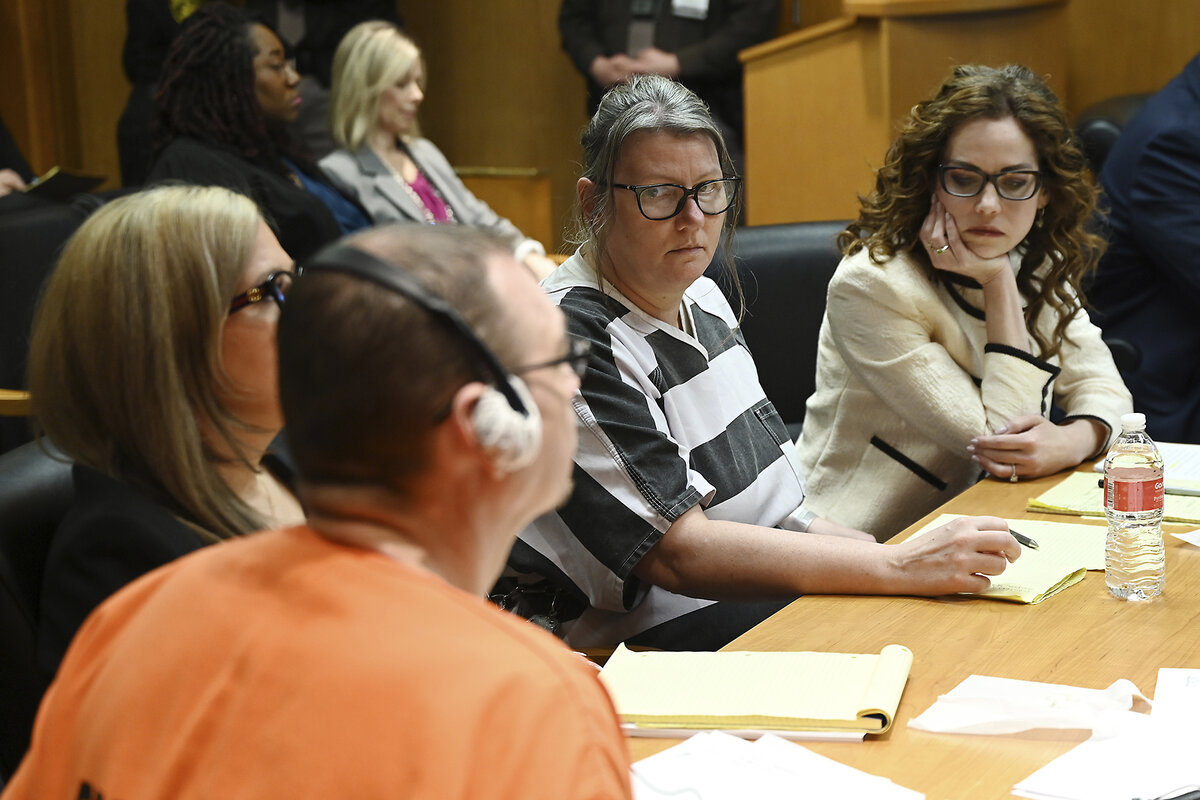
The key question for many Americans is, “What is a perpetrator this young doing with an AR-15?” says San Francisco-based writer Mark Follman, author of “Trigger Points: Inside the Mission To Stop Mass Shootings.”
The answer is elusive. Civil lawsuits after shootings often take aim at schools, law enforcement, and the weapons industry. With rare exception, those segments of society enjoy immunity from accountability.
As a result, “What we have seen is pressure pushed over and focused on parents,” says Georgia State University professor Tim Lytton. “They are bringing criminal charges against the father for doing something that is standard practice: provide children with weapons.”
The charges may be valid, adds Professor Lytton, but “the framing is now that this was an irresponsible father.”
It’s too soon to know whether increased focus on the parents of underage shooters will have any impact on gun laws.
Jennifer and James Crumbley, the first parents convicted for a mass school shooting by their child, were sentenced this past spring to at least 10 years in prison.
The successful, first-of-its-kind prosecution of teenager Ethan Crumbley and his parents in Oxford Township, Michigan, presented a novel theory under which “somebody could be convicted of involuntary manslaughter for their contribution to a chain of events that produced death,” says Evan Bernick, a professor at Northern Illinois University College of Law in DeKalb.
A remarkable shift
Georgia prosecutors have stepped up in this latest case even more, he says, including adding second-degree murder charges for Mr. Gray.
“The argument is that ... Colt’s intentional actions were foreseeable consequences of Colin’s negligence,” says Professor Bernick.
On its face, the strategy is hardly ironclad. Georgia law mandates that murder suspects be tried as adults, so the state will argue that Colt is an adult with moral acuity to act intentionally – and (in the other case) that he is a child whose father was negligent in safeguarding him. Despite such paradoxes, prosecutors who don’t bring charges in similar cases would now face “justifiable public outrage,” Professor Bernick says.
The “who’s responsible” debate this time includes Apalachee High School, where students in the Georgia Piedmont were just getting settled into the school year last week when gunfire broke out in the hallway. School officials may have received a warning about Colt’s intent before the shooting began.
But the focus is mainly on the Gray family, including Colt’s father. Federal law bars those under age 18 from buying rifles. You have to be 21 years old to buy a handgun. Georgia allows adults and teens to carry rifles in public, though not in school zones.
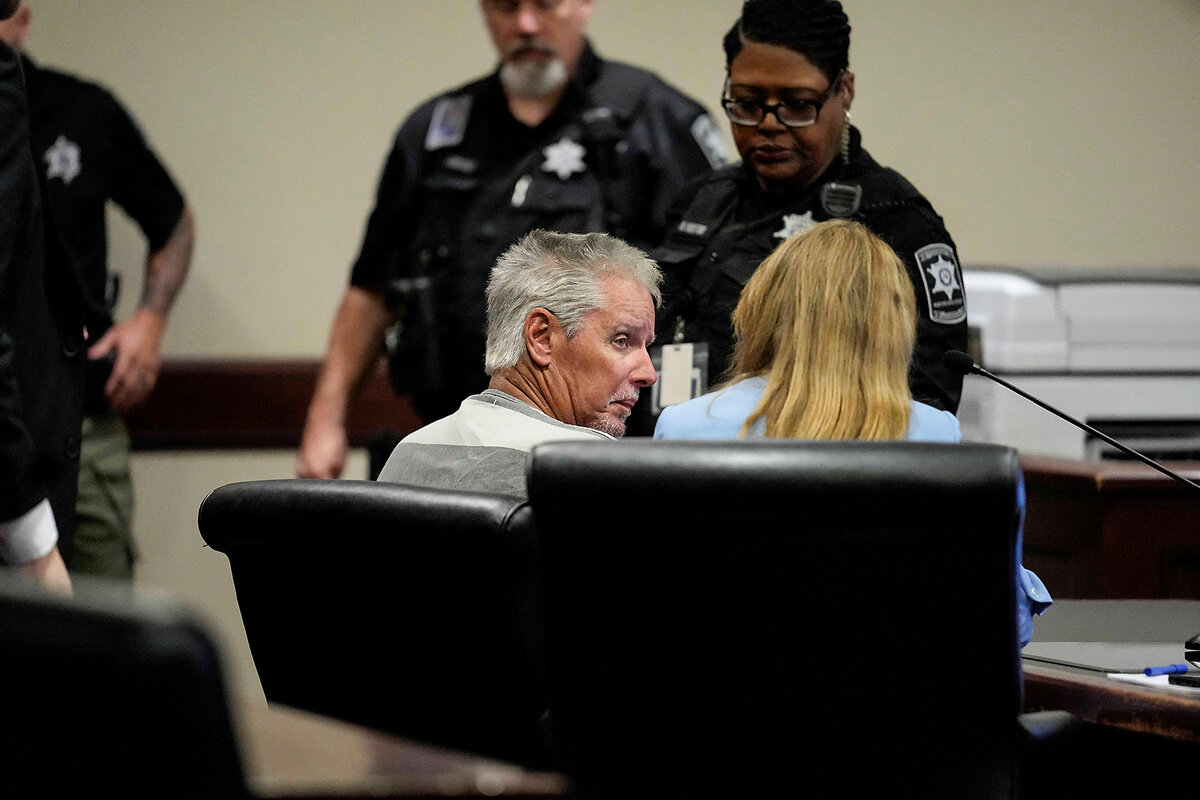
Barrow County is conservative. Seventy-one percent of the county’s voters supported Donald Trump in the 2020 election. And when Gov. Brian Kemp, a Republican, signed a landmark gun rights bill into law in 2022, he referenced giving a Glock handgun to his daughter, Lucy, who was 21 years old at the time of his speech.
But times may be changing. President Joe Biden won Georgia in 2020, and the state’s voters have sent two Democrats to the U.S. Senate. Democrats are typically more supportive of gun restrictions, including assault weapon bans.
That suggests gun rights and public safety may be in play even in traditionally conservative counties. In a meeting in Atlanta a day after the shooting, members of a state Committee on Safe Firearm Storage expressed anger about the Apalachee High shooting.
Family failure or social breakdown
Such public probes underscore that, given the unthinkable pace of shootings, parents may have to step up. After all, becoming a teenager on the way to adulthood “doesn’t come with a user manual,” says Aaron Stark, a mental health advocate in Denver. “That’s why the failure looks more on the family side, and possibly the school.”
Indeed, in a state like Georgia, “It is not necessarily inconsistent to favor broad gun rights and also impose responsibility to parents,” says Professor Winkler, a law professor at the University of California, Los Angeles. “There is an idea that only parents can really control the household and only parents can really keep guns out of the hands of dangerous children.”
In the days after the shooting, a wave of new threats hit schools nationwide. Highlighting a newfound vigilance by authorities, dozens of Georgia children – including a fourth grader – now face felony charges of making terrorist threats.
Earlier this week, Georgia’s Savannah-Chatham County Public Schools warned parents in a letter that “any student found responsible for making threats toward our schools or toward another student or staff member could face serious consequences, including felony charges.”
Whether that shift is enough to stem shootings is uncertain.
“The turn of attention to parents is a distraction from the fact that ... there’s no real motivation in many states to do much about access to firearms,” argues Professor Lytton, in Atlanta. “If the legal response is just individual culpability, then the ways to think creatively about addressing the problem shrink drastically.”

Today’s news briefs
• Alexei Navalny’s lawyers on trial: Three lawyers who represented the late opposition leader are being tried in Russia. Vadim Kobzev, Igor Sergunin, and Alexei Liptser were arrested in October 2023 on charges of involvement with an extremist group.
• Rise in foreign-born residents: The percentage of U.S. residents born outside the country reached its highest level in more than a century in 2023, according to a survey released Thursday by the U.S. Census Bureau.
• North Dakota abortion ban struck down: A judge rules that the state constitution creates a fundamental right to access abortion before a fetus is viable.
• First private spacewalk: Tech entrepreneur Jared Isaacman performs it, hundreds of miles above Earth, on Thursday. The high-risk endeavor was previously reserved for professional astronauts.

Ukraine’s Azov fighters, once sanctioned by US, strive to clear their name
Ukraine’s Azov Brigade has been much maligned, especially by Russia, for a Nazi-tainted past. But today its renowned fighters proudly and emphatically assert their modern self-definition as patriotic nationalists with a broad appeal.

- Quick Read
- Deep Read ( 6 Min. )
For the Azov team awaiting front-line casualties in its fortified dugout, the conversation shifts from paramedic chitchat to a dramatic change in U.S. policy that lifted restrictions on the fighting unit.
It’s a critical development for a brigade whose controversial antecedent included members with links to far-right groups and alleged neo-Nazi sympathies. But in June, a U.S. State Department vetting process found “no evidence” that Azov had engaged in gross human rights violations, allowing Azov fighters to participate in Western training and use weapons purchased with U.S. funds.
Azov reached legendary status across Ukraine for the against-all-odds defense of Mariupol in 2022. The soldier-medics in the dugout blame Russian propaganda for maligning their brigade, and say that right-wing connections of early Azov members diminished years ago and are not relevant.
Today Azov units include Jews, Muslims, and other Ukrainian minorities.
“It’s very important to tell about Azov,” says anesthetist Roman Shtybel, who says he has never heard or “felt” neo-Nazi inclinations in Azov.
“We have this idea of the Ukrainian nation, like keeping and preserving Ukrainian nationality,” says an Azov soldier who declined to be named. “That is what we fight for. ... We take everyone who feels they are Ukrainian – this is the most important.”
Ukraine’s Azov fighters, once sanctioned by US, strive to clear their name
For the Azov Brigade team awaiting front-line casualties in its fortified dugout, the day begins at dawn with a barrage of seven Russian missiles and then seven Grad rockets.
The barrage starts fires that must be put out.
“Now we spend more time as firefighters,” quips anesthetist Roman Shtybel, at this first stop for Ukrainian soldiers severely wounded on the front line. Hours after the Russian attack, some fires still smolder, and smoke filters among the tall pines in eastern Ukraine’s Kreminna Forest.
Inside the bunker, its thick log ceiling protecting three small treatment stretchers and its walls hung with lifesaving trauma gear, the conversation ranges. First, it focuses on paramedic chitchat: the evolution of wound types as Ukraine’s war has ground on more than 2 1/2 years, and the fact that this unit can provide blood transfusions, just 6.5 kilometers (4 miles) from the front.
But the 12th Special Forces Azov Brigade is no typical Ukrainian unit, and talk soon shifts to a dramatic change in U.S. policy. In June, the United States lifted restrictions on Azov receiving American weapons and training.
It’s a critical development for a brigade whose controversial antecedent – founded in 2014 as a volunteer militia – included members with links to far-right groups and alleged neo-Nazi sympathies.
In 2018, the House of Representatives imposed restrictions on the Azov Battalion, a predecessor to the Azov Brigade, with some lawmakers citing neo-Nazi connections.
But in June, a separate State Department vetting process under Leahy laws found “no evidence” that Azov had engaged in gross human rights violations. It also reportedly found that the 2018 congressional restrictions did not apply to the reorganized and renamed brigade. That opened the way for Azov fighters to take part in Western training exercises and to use weapons purchased with U.S. funds.
The brigade’s reassessed status was not news to these soldier-medics, who say that right-wing connections of early Azov members diminished years ago and are not relevant today. They are proud, they say, to be part of a unit that is now renowned in Ukraine for its fighting prowess, fearlessness, and reputation for taking care of its own.
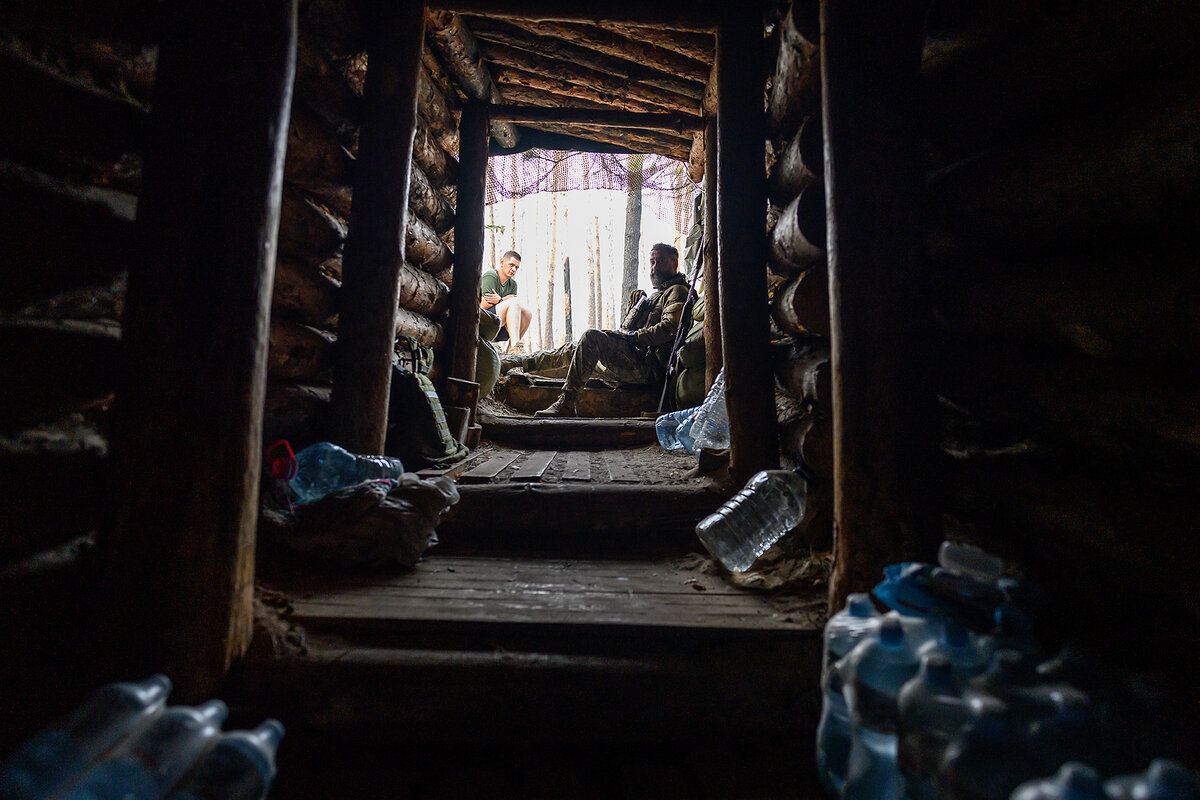
Russian accusations called propaganda
They dismiss as Russian propaganda accusations that Azov is part of what President Vladimir Putin calls the “neo-Nazi Kyiv regime.” It’s a canard, they say, that Moscow used in 2014 to justify annexing Ukraine’s Crimean Peninsula and justify supporting separatist militias in eastern Ukraine, and used again in February 2022 to justify the all-out invasion of Ukraine to “de-nazify” its southwestern neighbor.
“It’s very important to tell about Azov. ... It’s not about [making] changes, because it was never Nazis,” says Mr. Shtybel, who says he has never heard or “felt” such inclinations in Azov.
“In every army, you have right-sided guys. It’s normal, because a military structure is more about power, about directions, about following commanders. It’s not liberty there, or democracy,” says Mr. Shtybel, who reads Ernest Hemingway’s “The Old Man and the Sea” in English during breaks, because he notes the author experienced war firsthand.
“Azov wasn’t so very special; it’s not like a concentration of Nazis here,” he says. Azov was effective in 2014 and a “very big threat to Russia,” and remains “one of the best units in the army. Just imagine what it would be if there was no limitation on it.”
Russian propaganda, adds Mr. Shtybel, was “just about discrediting [Azov] in the world. It’s just what they do for the whole nation now, saying that Ukrainians are Nazis – the whole nation. You are ‘Nazis’ just when you want to exist.”
Azov was integrated into Ukraine’s National Guard in 2015, and its officers say “massive” efforts have been made to burnish its reputation and remove the neo-Nazi taint. Still, Russia’s presidential spokesperson Dmitry Peskov charged that the American decision in June showed the U.S. was “even prepared to flirt with neo-Nazis” to stop Russia.
“I never had any doubt that this ban would be lifted, because we did everything we could to show to everyone that Azov is an open brigade,” says an Azov soldier in eastern Ukraine who asked not to be named.
An Azov statement at the time said the unit’s “combat capability” would increase, and that Russia’s “lies ... received a devastating blow.” Still, the soldier says Azov’s ideology of patriotic nationalism has made it vulnerable to misinterpreted aims.
Indeed, the emblem of Azov are the letters I and N superimposed upon each other, which the unit says represents the words “Idea of the Nation” in Ukrainian and has no other political connotation. However, an inverted version of the design, called a Wolfsangel – commonly used in German heraldry for centuries to depict a wolf trap – was also used by several Nazi units during World War II.
“Nation ... is what we fight for”
“We have this idea of the Ukrainian nation, like keeping and preserving Ukrainian nationality,” says the soldier. “The problem is that when people hear the word ‘nation,’ they automatically start to think of us as Nazis, but that is not correct.
“Nation is just who we are, and that is what we fight for. ... We take everyone who feels they are Ukrainian – this is the most important,” he says.
Azov units include Jews, Muslims, and other Ukrainian minorities.
“It’s just a faith in Ukraine, in your country, in your nation,” the soldier adds. “It’s just like Americans. They believe in their nation; they are proud of their country. That’s it; it’s the same for us.”
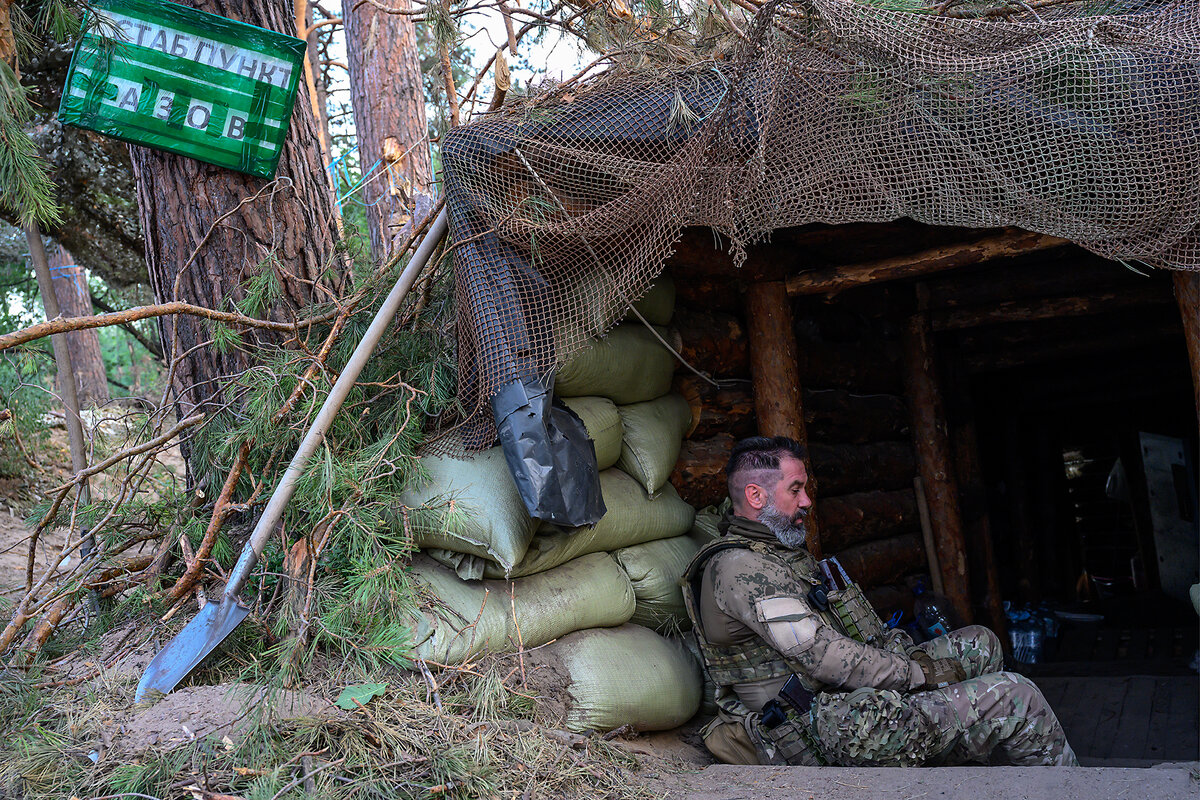
Azov reached legendary status among many Ukrainians for its fierce and monthslong, against-all-odds defense of the southern port city of Mariupol in 2022. Its final stand at the sprawling Soviet-era Azovstal steel works inspired soldiers across Ukraine, until the troops were ordered to surrender to Russia in May 2022 to save their lives. Some Azov soldiers from that battle have since been returned to Ukraine in prisoner exchanges, but more than 900 remain in Russian captivity.
This Azov unit arrived in the Kreminna Forest last summer, and then joined with the 1st Presidential Brigade of the National Guard in the lacework of Ukrainian and Russian trenches. The lines move little and make this forest treacherous ground for both sides.
Together this spring, they pushed Russian troops back 1 kilometer, along a 2-kilometer-wide swath. That advance came as, at every other point along Ukraine’s eastern front, Russian forces were on the offensive.
Indeed, Azov announced on Sept. 6 that some of its forces had relieved encircled Ukrainian units in the eastern Donetsk town of Niu-York, and reportedly made some gains.
“I decided to go with the best people”
That is why surgeon Volodymyr Halenko went out of his way to join Azov when he received call-up papers in the spring. He remembered hospital experiences a decade earlier, when Ukrainian soldiers from non-Azov units would arrive, hurt, and went through what he called “bureaucratic hell” – including being forced to prove that their injuries were sustained on the battlefield – before they received any benefits.
By contrast, wounded Azov members would arrive, and immediately someone from the broader Azov support group would be there to help. They would give the soldier a new mobile phone and a power bank – anything that they needed, he says – and Azov would evacuate them to better hospitals if they could be moved.
“When I knew I was going into the army, I decided to go with the best people – where I knew I would be valuable,” says Mr. Halenko, as he waits for casualties at the edge of the Azov stabilization point bunker after nightfall, under an acrid layer of smoke from the forest fire. The flash of outgoing fire elsewhere punctuates the darkness.
“It gives me very special motivation. After what I saw, it is important to know that I would not be left alone,” says Mr. Halenko, who says he has been especially impressed by the professionalism of Azov combat medics, and their decisions under fire, which “influence levels of survival.”
“We can’t afford not to respect our fighters, and the word gets out,” says the Azov soldier in eastern Ukraine. Azov is known for careful recruiting, and for investing time in educating and training its fighters and specialists. It has a formal support group, rare in the Ukrainian military, called Azov’s Angels, that extends well beyond its fighters.
“The brigade takes care of all the soldiers and all the families from beginning to end, as needed,” he says. “People are the most valuable asset, and the biggest value in this brigade. That’s why it’s a very common thing to hear from soldiers that Azov is a family.”
Reporting for this story was supported by Oleksandr Naselenko.

Patterns
Moscow gets Iranian missiles: Might that actually help Kyiv?
Iran’s dispatch of ballistic missiles to Russia could backfire if the shipment provokes Washington into lifting its refusal to let Ukraine aim U.S.-made long-range missiles deep into Russian territory.

- Quick Read
- Deep Read ( 4 Min. )
Iran’s dispatch of hundreds of ballistic missiles to Russia, bolstering Moscow’s relentless bombardment of Ukraine, has put the United States and its Western allies in a bind.
On the one hand, Washington is tempted to make Tehran pay a high price for ignoring the administration’s repeated warnings not to ship the missiles.
On the other hand, the U.S. needs Iranian cooperation to keep the lid on the Middle East and prevent the war in Gaza exploding into a full-scale regional conflict.
How to balance those two very different objectives in two very different wars?
It could be that Iran’s move will provoke Washington to allow Ukraine to aim U.S. and British long-range missiles deep into Russian territory, which it has so far been forbidden to do.
The Ukrainian government and a number of European NATO members have long wanted the Biden administration to lift the restriction.
They reason that Kyiv should be able to target the launch bases and airfields from which Russia launches its bomber planes and missiles, which are currently out of Ukrainian range.
If Mr. Biden does now decide to ease the restrictions, it may be that Iran’s arms shipment will turn out to have done its ally more harm than good.
Moscow gets Iranian missiles: Might that actually help Kyiv?

Iran’s dispatch of hundreds of ballistic missiles to Russia, bolstering Moscow’s relentless bombardment of Ukraine, has put the United States and its Western allies in a bind.
On the one hand, Washington is tempted to make Tehran pay a high price for ignoring the administration’s repeated warnings not to ship the missiles.
On the other hand, the U.S. needs Iranian cooperation to keep the lid on the Middle East and prevent the war in Gaza exploding into a full-scale regional conflict.
How to balance those two very different objectives in two very different wars?
The immediate Western reaction – a fresh round of sanctions against Tehran this week – was, in effect, the diplomatic equivalent of a motor-muscle response. What matters now is what comes next.
It is too early to gauge just how the Western allies, and Iran itself, will handle their diplomatic tug-of-war in the days ahead. But the tussle may clear the way for a decision that Ukrainian President Volodomyr Zelenskyy has been demanding for months: Washington appears to be drawing closer to allowing Ukraine to aim U.S. and British long-range missiles deep into Russian territory, which it has so far been forbidden to do.
In the Middle East, Washington’s goal has long been to dissuade Iran, and the Iranian-armed Hezbollah militia in Lebanon, from actions that could widen the war in Gaza.
In Ukraine, it has been to arm Kyiv against Russia’s invasion – but without risking the kind of further Russian escalation that could draw NATO countries directly into the conflict.
The allies hope that Iran still wants to avoid a regional Mideast war.
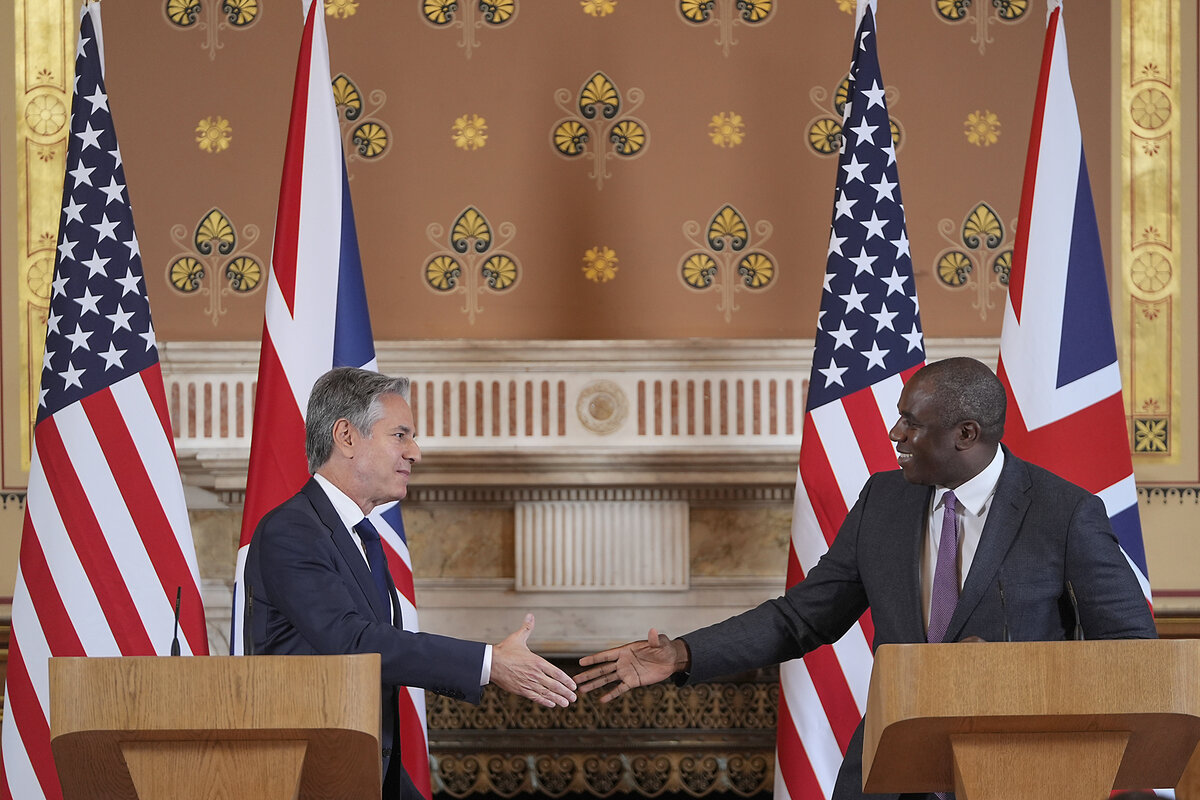
It has powerful motives for that: to spare huge damage to its struggling economy and avoid further popular disaffection toward the ruling clerics, among other things.
But in Ukraine, Iran appears to have made a different risk-benefit calculation.
And that’s why Washington and its allies now seem readier to send a stronger message.
The Iranian arms shipment – 250 mobile, truck-mounted Fath-360 ballistic missiles, with a range of up to 120 miles – was the latest sign of an increasingly close military partnership with Moscow. Iran has already provided Russia with Shahed attack drones, and helped set up facilities for the Russians to manufacture them.
For its part, Iran stands to receive high-end Russian air defense systems, as well as help on its nuclear program.
The new U.S. and European sanctions are unlikely to make little immediate difference to Tehran.
Still, the way the sanctions announcements were framed – all but eliminating the prospect of international reengagement or sanctions relief – will have driven home the longer-term cost Iran could pay.
European governments have long been seen as more amenable than Washington to improved relations with Iran. But Britain, France, and Germany said they imposed their sanctions because they see the missile shipment as “Iranian missiles reaching European soil” in a “direct security threat to Europe,” in the words of their joint announcement.
U.S. Secretary of State Antony Blinken, visiting London this week before accompanying British Foreign Secretary David Lammy to Kyiv, expanded on that message.
“Iran’s new president and foreign minister have repeatedly said that they want to restore engagement with Europe,” he said. “They want to receive sanctions relief. Destabilizing actions like these will achieve exactly the opposite.”
Whether this has any impact will become clear only in the weeks ahead, as Western governments look to see whether Iran makes further missile deliveries to Russia.
But a more immediate effect could well be felt in Ukraine itself.
A number of European NATO members, especially those nearest to Russia, have long wanted the Biden administration to lift the restriction on Ukraine’s use of the long-range Western missiles that they have been given.
They reason that Kyiv should be able to target the launch bases and airfields from which Russia launches its bomber planes and missiles, such as the Iranian Fath-360s, which are currently out of Ukrainian range.
They are also concerned that the Iranian weapons – far more reliable and accurate than the munitions Russia has received from North Korea – will free Moscow to use its own longer-range missiles for intensified strikes across Ukraine.
That is a message Mr. Blinken is carrying back to Washington ahead of talks this Friday between Britain’s new prime minister, Keir Starmer, and President Joe Biden.
If Mr. Biden does now decide to ease the restrictions, it may be that Iran’s arms shipment will turn out to have done its ally more harm than good.

Difference-maker
Tractors can kill. Farm safety for teens can save lives.
About every three days, a child in the United States dies from an agriculture-related injury. One expert is cultivating lifesaving skills among teen farmers.

- Quick Read
- Deep Read ( 5 Min. )
-
By Patricia Leigh Brown Contributor
Spend a little time with Ellen Duysen, and you’ll hear about the 7-year-old in South Dakota who suffocated in a grain wagon, the 14-year-old in Iowa who was killed when his family was changing a tractor wheel, or the gas can explosion in the same state that killed an 11-year-old.
Tragedies can happen in an instant, whether it’s a tractor hitting a hidden prairie dog hole or a farmer taking a moment to pick sweet corn and forgetting to set the parking brake.
“Oh my gosh, you can become so saddened by the statistics,” Ms. Duysen says. “When you hear about these young farmers dying, it becomes a passion to keep them safe and healthy.”
Ms. Duysen is the sneakers-on-the-ground expert educating farmers in seven states across the Midwest and the Great Plains. As outreach coordinator for the Central States Center for Agricultural Safety and Health in Omaha, Nebraska, she aims to cajole and inspire young farmers to embrace a “culture of safety” to protect them from the myriad hazards claiming the lives of far too many of their peers.
Tractors can kill. Farm safety for teens can save lives.
Ellen Duysen has driven 470 miles across Nebraska to get here, her windshield streaked with bugs. Her task: to impart safety lessons to a group of 14-year-old farmers in the state’s far west corner.
As outreach coordinator for the Central States Center for Agricultural Safety and Health in Omaha, Ms. Duysen aims to cajole and inspire young farmers to embrace a “culture of safety” to protect them from the myriad hazards claiming the lives of far too many of their peers.
“What are you doing for fun this summer?” Ms. Duysen asks the five teenagers assembled at the Legacy of the Plains Museum in Gering, situated amid a landscape of buttes and two-lane roads.
“Raising show pigs,” 14-year-old Trey Carter pipes up.
“They’re naughty, aren’t they?” says Ms. Duysen, who has raised pigs herself and whose easygoing manner helps build rapport with the teens before she begins discussing the perils of farmwork.
Tragic statistics
About every three days, a child in the United States dies from an agriculture-related injury, and the agricultural sector leads the nation in the number of occupational fatalities for youths 17 and under, according to the National Children’s Center for Rural and Agricultural Health and Safety. Youths under age 16 have 12 times the risk of injuries involving all-terrain vehicles compared with adults, with some 300 children dying each year. Tractor accidents are the leading cause of death on farms, with roughly half of the vehicles lacking safety devices designed to prevent potentially fatal rollovers.
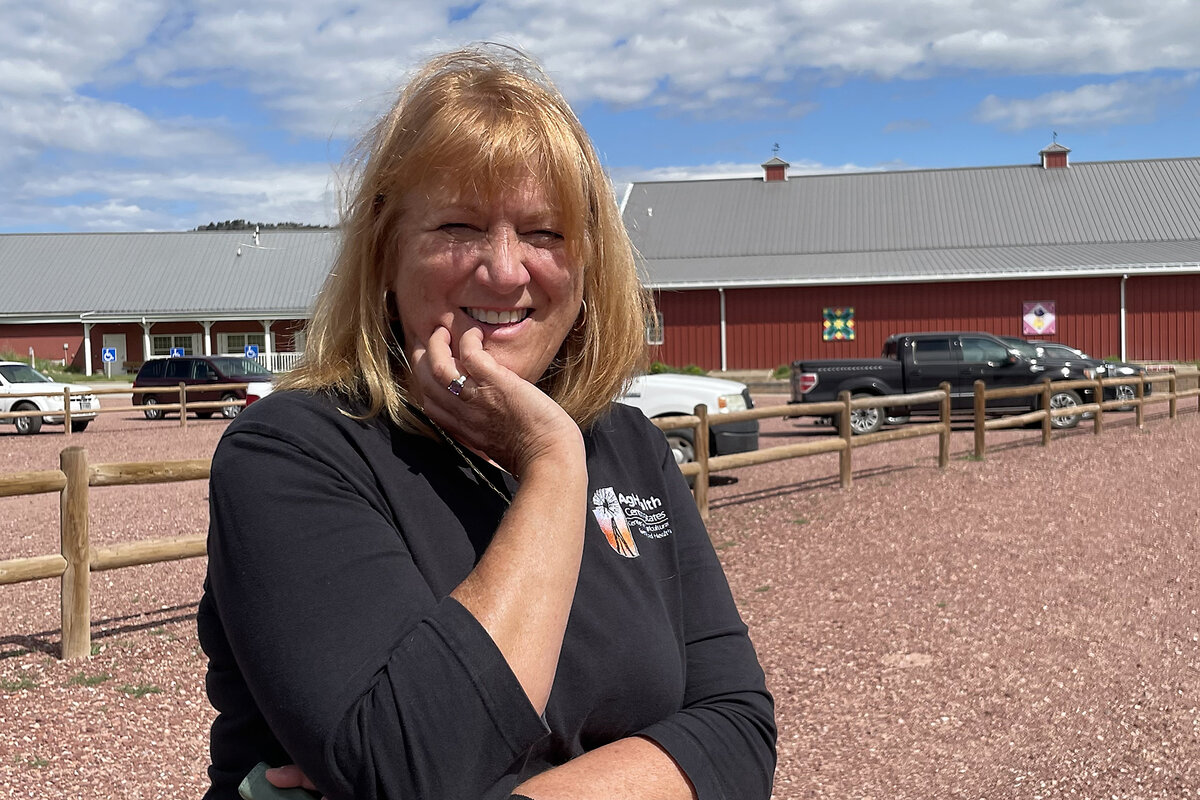
Ms. Duysen is the sneakers-on-the-ground expert educating farmers in seven states across the Midwest and the Great Plains. She is often accompanied by Pat, a male mannequin that she calls “gorgeous” and “delightful” and that helps her demonstrate personal protective equipment (PPE). Her home base at the University of Nebraska Medical Center is one of 12 centers around the country established by the National Institute for Occupational Safety and Health (NIOSH), a branch of the Centers for Disease Control and Prevention.
Spend a little time with Ms. Duysen, and you’ll hear about the 7-year-old in South Dakota who suffocated in a grain wagon, the 14-year-old in Iowa who was killed when his family was changing a tractor wheel, or the gas can explosion in the same state that killed an 11-year-old. Tragedies can happen in an instant, whether it’s a tractor hitting a hidden prairie dog hole or a farmer taking a moment to pick sweet corn and forgetting to set the parking brake. “Oh my gosh, you can become so saddened by the statistics,” Ms. Duysen says. “When you hear about these young farmers dying, it becomes a passion to keep them safe and healthy.”
For the teens gathered at the museum in Gering, the day is a chance to earn a certificate that will allow them to legally drive tractors for people other than their parents, potentially enhancing their incomes. Federal law prohibits children under 16 from driving tractors unless their parents or legal guardians own the farm or unless they have certification. To gain certification, the teens will have to navigate a tractor with an attached trailer through a maze of orange cones set up in the museum parking lot.
With humor and heart
The teens’ skills will be evaluated by John Thomas, a local agricultural extension educator who typically advises farmers on growing sugar beets, beans, and other crops. Ms. Duysen always breaks the ice in her training sessions by asking, “What’s the weirdest food you’ve ever eaten?” Today’s replies – tuna casserole, seaweed, pickles submerged in Dr Pepper – are eclipsed by Mr. Thomas’ recipe for freezing a thousand live crickets and then sprinkling them with olive oil and salt before baking.
“Remind us never to come to your barbecue,” Ms. Duysen quips.
With sly humor and an energy belying four hours of sleep, she leans into hands-on learning, from a “stop the bleed” exercise with limbs made out of denim-wrapped pool noodles spattered with fake blood to a PPE fashion show in which the teens model noise-reducing earmuffs, face shields, and air-purifying respirators. “This is the bomb!” Ms. Duysen enthuses about the show.
She uses a miniature plastic farmer submerged in corn kernels to demonstrate how farmers can easily become engulfed in grain bins – what some call Midwestern quicksand. “We’ve lost three good Nebraska men this year already,” she says. “Do not go in that bin.”
She also asks her young charges how they might say no to a boss demanding that they do so. “Respectfully, sir, I’m too young to die,” volunteers Kenley Dehning, one of three young women in the group.
She and her fellow teens completed an online course before the training, including homework. Kenley tallied the state’s farm injuries and fatalities, noting gender disparities. “Heck yeah!” Ms. Duysen says in response to the research. Rainee Olson interviewed her uncle, who was 11 years old and eating lunch on a tractor when he accidentally hit the gear shift and fell off, crushing his arm and ankle and pulling off an ear. (“They sewed it back on,” Rainee reports.)

“An expert who has lived it”
Ms. Duysen is highly attuned to agricultural injuries, having had one herself. She was 26 and working for a veterinary pharmaceutical company in Colorado when she attempted to collect a blood sample from a heifer, who was secured in a head gate. As she leaned down, the heifer’s noggin collided with her own, knocking out her front teeth. The oral surgeon identified the heifer’s color by the red hairs in Ms. Duysen’s mouth. The experience changed Ms. Duysen’s approach. “I slowed down, for dang sure,” she says.
She grew up in Phoenix, the daughter of a psychologist and a newspaper editor, with four brothers (“it made me super tough”). After working as a microbiologist, she eventually decided to get a master’s degree in public health; providentially, the agricultural center opened six months later. She and her husband, Jack, a contractor, raised their three sons on a farm in Carson, Iowa.
In 2010, her center and four others launched the Telling the Story Project in which farmers reflect on their injuries and how they might have been prevented. The concept grew out of some 500 interviews Ms. Duysen and her now-retired mentor, Shari Burgus, conducted.
Jennifer Lincoln, associate director at NIOSH, credits Ms. Duysen for her role in the project, “calling it a very powerful tool.”
“There’s a difference between having an ‘expert’ and an expert who has lived it,” she adds.
This summer, Ms. Duysen also planned to set up shop at agricultural fairs like Husker Harvest Days, where she would entice grown-ups with free bucket hats – better sun protection than the baseball caps that many farmers wear. For lunch, she would grab a pork chop on a stick.
“If everyone was cautious, it would probably put us out of work,” she muses. There will be umpteen thousands of miles driven and who knows how many safety sessions with teenage farmers before then.

Points of Progress
Stubborn problems overcome: Where hunger is dropping and weeds build homes
Long-term problems like housing shortages and hunger can feel insurmountable. This week’s progress roundup shows significant movement on both fronts. In Latin America, food insecurity declines. And in Namibia, innovative management of an invasive species is helping to boost housing stocks.
Stubborn problems overcome: Where hunger is dropping and weeds build homes

How a contest for cargo ships is saving whales
A contest for cargo ships is protecting whales by encouraging traffic to slow down. Fatal collisions with whales have ticked upward as maritime shipping has grown globally and warming waters have changed animals’ patterns of movement. Off the U.S. west coast, some 80 endangered whales are killed in ship strikes annually.
In the Protecting Blue Whales and Blue Skies contest run by the federal government since 2014, companies are rewarded for reducing ship speed along the coast of California. Last year, 81% of the distance ships traveled was at the recommended speed of 10 knots per hour or less, and fatal collisions fell by 58%. Firms used to receive cash prizes – but bragging rights have become reward enough.
This spring, whale scientists launched a real-time tool that tracks whales and ships’ compliance with speed limits, detailed data that is helping companies improve their performance.
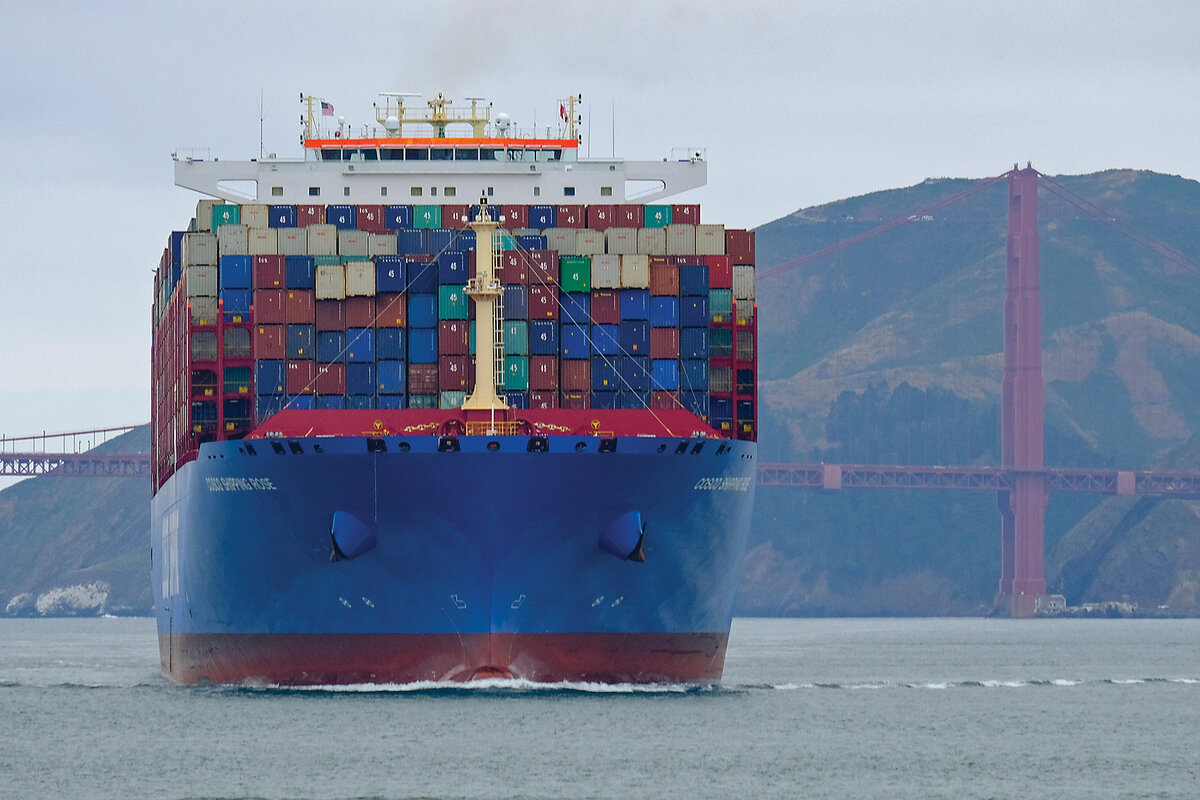
In addition to causing fewer collisions, slower ships generate fewer air pollutants and less noise. In 2023, there were more contest participants – 33 companies – than ever before.
Sources: The New York Times, Inside Climate News
Latin America takes big strides in reducing hunger
Hunger and food insecurity declined in South America, according to the latest United Nations reports. Ending poverty, hunger, food insecurity, and malnutrition are among the U.N.’s top Sustainable Development Goals to achieve by 2030.
Healthy food in Latin America and the Caribbean costs more than elsewhere in the world. But in comparison with Africa and Asia, Latin America has the lowest percentage of its population experiencing hunger, 6.5%. Conditions varied among nations, and progress was largely limited to South America. The Food and Agriculture Organization’s chief economist partly attributes improvements after the pandemic to the region’s effective fiscal institutions, central banks, and social safety nets.

Sources: Financial Times, Food and Agriculture Organization of the United Nations
Germany makes it easier for consumers to reuse containers
Germany is encouraging its reuse culture beyond beverage containers. For decades, the country has run a highly successful “deposit return scheme,” in which consumers get money back for their returned bottles and cans, and some manufacturers cooperate to reuse standardized glass containers.
As members of the Mach Mehrweg Pool (Make Reusable Pool), companies are now using shared glass containers for everything from yogurt to coffee beans. The pool estimates each container is cleaned and reused up to 50 times.
Critics point out that the number of single-use plastic bottles has actually increased since the system’s inception, due to lower manufacturing and handling costs for giant discount stores. Three-quarters of PET (polyethylene terephthalate) bottles are recycled into other products, not bottles, or incinerated. But return rates for all types of beverage containers in Germany exceed 96%.
Sources: The Guardian, Bloomberg
In Namibia, an invasive weed is helping solve a housing shortage
Mushrooms and invasive weeds are one new solution to a housing crisis in Namibia. The country must build at least half a million homes to address its shortage. Additionally, more than half the country is affected by encroachment from Acacia mellifera, invasive bushes that push out native species and compromise groundwater. A national program will make wood dust out of 330 million tons of bushes over 15 years.
At MycoHab Namibia, the wood dust becomes a growing medium for oyster mushrooms. As the mushrooms grow on top of the substrate, their rootlike mycelium network expands in the medium to become a material that can be compressed and heated into building blocks. The mushrooms are sold as food.
Researchers say cost is an issue, as the bricks are heavy and expensive to transport. But the blocks are insulating and fireproof, and sequester carbon. MycoHab Namibia opened its first home to the public earlier this year.
Sources: The Guardian, Architizer
Same-sex couples in South Korea gain new rights
The Supreme Court ruled that same-sex couples qualify for health insurance benefits, a landmark decision that could lead to further legal recognition. Under South Korean law, married couples and those in common-law marriages can extend the health insurance benefits of one partner to the other.
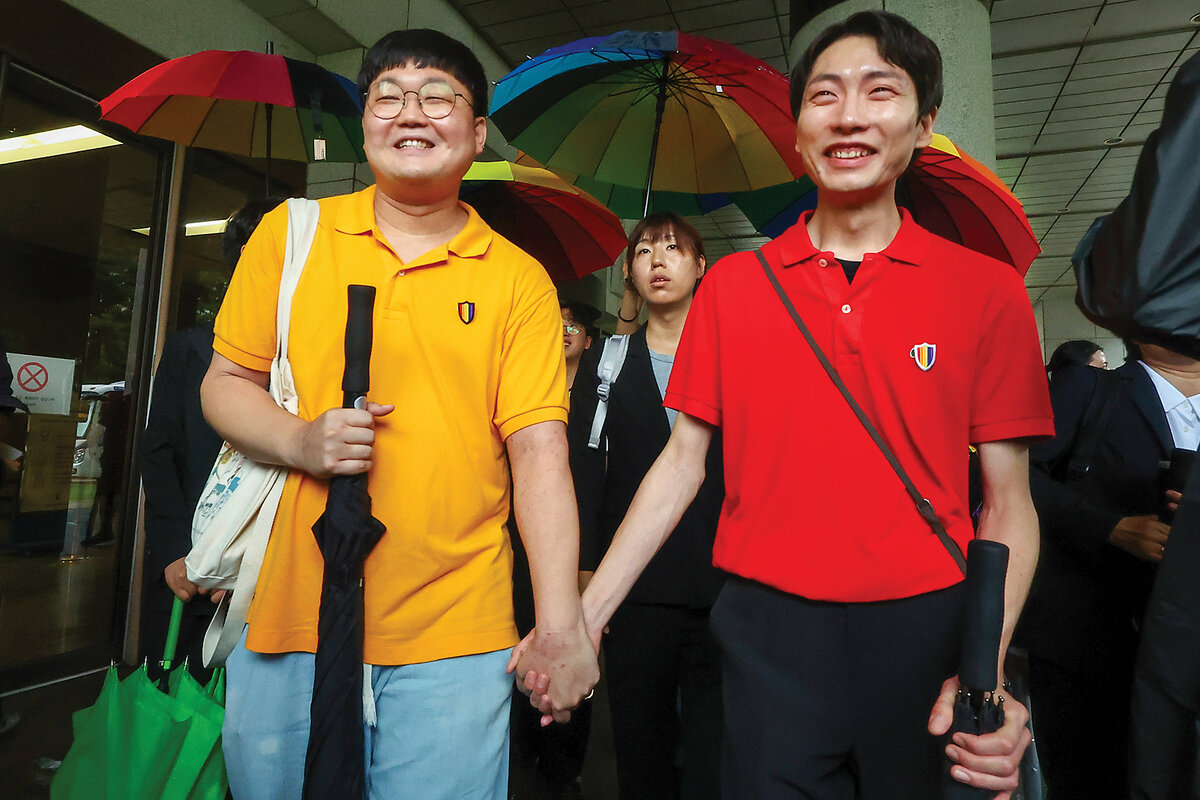
The justices upheld the decision of a lower court, which found that though So Seong-wook and Kim Yong-min’s relationship could not be considered a common-law marriage, denying them insurance privileges available to straight couples is discriminatory and unconstitutional. The ruling is final and cannot be appealed.
Though same-sex marriage remains illegal in South Korea, public opinion has become more accepting. Some 40% of South Koreans support gay marriage as of last year, up from 17% in 2000.
Source: The New York Times

Other headline stories we’re watching
(Get live updates throughout the day.)The Monitor's View
Cherishing ‘climate volunteers’
- Quick Read
- Deep Read ( 2 Min. )
-
By the Monitor's Editorial Board
Not many nations reinvent themselves twice within one month. Yet in August, Bangladesh did just that.
First, a student-led uprising forced an autocratic ruler to flee, restoring democracy in the South Asian country and renewing people’s faith in civic equality. Then days later, a country with the world’s largest delta saw its worst flooding in more than three decades. Perhaps in part because of the democratic renewal, citizens by the tens of thousands gave time and money to more than 5.5 million people affected by the heavy rains.
The spontaneous generosity ranged from girls breaking open their piggy banks to famed actors taking supplies to inundated villages. “The flooding has given us an opportunity to rediscover a missing characteristic of the nation – the united strength,” wrote journalist Shiabur Rahman. “The empathy the nation has shown for the flood victims is unprecedented.”
As the low-lying country experiences increased flooding from extreme weather, it is setting a model for citizen participation in climate action.
“Very few pay attention to the skills of volunteers and citizens who often lead response as disasters unfold,” says Janne Parviainen, a researcher at the Stockholm Environment Institute.
Cherishing ‘climate volunteers’

Not many nations reinvent themselves twice within one month. Yet in August, Bangladesh did just that.
First, a student-led uprising forced an autocratic ruler to flee, restoring democracy in the South Asian country and renewing people’s faith in civic equality. Then days later, a country with the world’s largest delta saw its worst flooding in more than three decades, lasting into early September. Perhaps in part because of the democratic renewal, citizens by the tens of thousands gave time and money to more than 5.5 million people affected by the heavy rains.
The spontaneous generosity ranged from girls breaking open their piggy banks, to famed actors taking supplies to inundated villages, to a concert with some 30 bands raising money. The university students who led the uprising quickly pivoted to aid work and donation collection.
“The flooding has given us an opportunity to rediscover a missing characteristic of the nation – the united strength,” wrote journalist Shiabur Rahman in The Financial Express.
“The empathy the nation has shown for the flood victims is unprecedented,” he stated. “Volunteers – both trained and untrained – coming from different strata of society rushed to the affected areas to join the relief activities risking their lives, alongside the government efforts.”
Mr. Rahman makes a crucial connection between the two big events in August: “If we enjoy more freedom and get united, combating disasters will be easier for us.”
Bangladesh is already known as a social innovator with its use of microloans for poor people to start a business. And with other wise reforms, its poverty rate has plummeted in recent years. Yet as the low-lying country experiences increased flooding from extreme weather, it is also setting a model for citizen participation in disaster response. The mass action in August and into September by its “climate volunteers” has not gone unnoticed in other countries working to increase volunteerism to deal with wildfires, storms, and drought.
“Very few pay attention to the skills of volunteers and citizens who often lead response as disasters unfold,” Janne Parviainen, a researcher at the Stockholm Environment Institute, wrote for Euractiv media network last year. He adds that a bottom-up approach to climate adaptation “should be cherished.” In Bangladesh, for sure, people now cherish their climate volunteers, perhaps as much as they cherish their democracy.

A Christian Science Perspective
Each weekday, the Monitor includes one clearly labeled religious article offering spiritual insight on contemporary issues, including the news. The publication – in its various forms – is produced for anyone who cares about the progress of the human endeavor around the world and seeks news reported with compassion, intelligence, and an essentially constructive lens. For many, that caring has religious roots. For many, it does not. The Monitor has always embraced both audiences. The Monitor is owned by a church – The First Church of Christ, Scientist, in Boston – whose founder was concerned with both the state of the world and the quality of available news.
Your ability to heal
- Quick Read
- Read or Listen ( 4 Min. )
-
By Eric Nelson
The love that sees everyone as spiritual and whole takes away fear and brings healing.
Your ability to heal
Think you don’t have what it takes to heal as Jesus did? Think again. There isn’t anyone who doesn’t have it in them to heal, because there isn’t anyone who doesn’t have it in them to love as Jesus loved. It really is that simple.
I remember a time many years ago when this idea really hit home. It was during a family vacation when my then seven-year-old nephew and I were sharing a room. In the middle of the night I awoke to find that he’d had a heavy nosebleed. (His mother had told me earlier that this had been happening on an occasional basis.)
Rather than trying to wake him from a sound sleep to clean things up, I decided to take a few moments just to love my nephew. This included an earnest desire to see him as I knew God saw him, right then and there – not as a frail, matter-based mortal subject to nosebleeds, but as God’s wholly spiritual, dearly beloved child.
To some that may sound like little more than positive thinking. But it really is a potent form of prayer. It was also a welcome reminder of the presence and power of Christ, the divine message from God that assures us that we have nothing to fear – that there isn’t any situation where God is not looking after us, where He’s not loving us. If this was true for me, as I understood it to be, then it was true for my nephew as well.
I must have fallen asleep, as the next thing I knew it was morning and my nephew had already made his way to breakfast. As I walked into the kitchen, I heard his mom ask how he’d slept. “Great,” he said, without even a mention, or any apparent memory, of what had happened. I was told later that soon after, these nosebleeds came to an end.
So what had happened here? Was this just about me entertaining a few loving thoughts about my nephew and seeing something amazing happen as a result? I don’t think so. To borrow a phrase from the New Testament (see, for instance, Matthew 14:14), I would describe it instead as my being “moved with compassion” – being inspired by God to see something of the inherent innocence of God’s creation – as my reflecting, in some measure, the love of divine Love itself, God, which enables us all to see this same reflection of Love in others.
Mary Baker Eddy, who discovered the divine Science behind the healings that we read about in the Bible – and that point to our own ability to heal – writes, “As the reflection of yourself appears in the mirror, so you, being spiritual, are the reflection of God. The substance, Life, intelligence, Truth, and Love, which constitute Deity, are reflected by His creation; and when we subordinate the false testimony of the corporeal senses to the facts of Science, we shall see this true likeness and reflection everywhere” (“Science and Health with Key to the Scriptures,” p. 516).
And, I might add, in everyone.
Of course, no one was better at this than Christ Jesus. Jesus loved; therefore, Jesus healed. But it was less about what Jesus was thinking, or even what he was saying, than about the love of God he was reflecting, the purity of God’s creation he was seeing, and the curative effect that such a divinely inspired view had on others.
So it is with us. In proportion to our commitment to love as Jesus did, our capacity to heal as Jesus did will increase.
Now, loving others as completely and consistently as Jesus did isn’t always easy. There are times when we don’t feel we have the patience to love, or we’ve somehow convinced ourselves that there are those who just aren’t worthy of love. Although such less-than-loving thoughts may seem normal, even justifiable, whatever resistance we might be feeling to thinking and acting in accord with our all-loving creator is actually unnatural.
“We love because God first loved us,” it says in the Bible (I John 4:19, Common English Bible), the implication being that our impulse to love and, by association, our ability to heal are compelled by a power that can’t be resisted. Sometimes all it takes to jump-start a healing is to be reminded of this fact.
Where there is love, there is no fear, declares the writer of First John (see 4:18). And where there’s no fear, there’s healing.
Adapted from an article published in the May 13, 2024, issue of the Christian Science Sentinel.

Viewfinder
Taking flight

A look ahead
Thanks for diving into your Daily today. We’ll be back tomorrow with a story from Michigan on the politically important question of whether the Biden administration stands to get credit for its actions around what our writer calls “the popular but amorphous topic of infrastructure.” Also, Peter Rainer breaks down this year’s Toronto International Film Festival.



